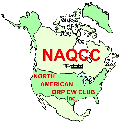
 | NAQCC News |
| Feb 28, 2009 | NAQCC Web Site | Issue #089 | |
|---|---|---|---|
| In this issue: 1. March Challenge. 2. February Sprint Results 3. General Club News 3a. KX-1 Project 4. Elmer Project 5. Latest Award Winners 6. News Items and Articles by Our Members |
| 1. MARCH CHALLENGE: A dozen members enjoyed the first running of our QSO Points Challenge in March 2008, so we're re-running it this March to see if it is still as popular. You'll have to read the actual rules for all the details, but basically we award points for different kinds of QSO's during the month, then you total up your points and submit them before the deadline. A prize comes with this month's challenge in addition to certificates to the three members making the most points. The prize is a set of 24 crystals covering all the bands from 160 through 10 meters donated by Rich N4ESS of Expanded Spectrum Systems. They go the highest scorer with a tiebreaking setup in effect if we do have a tie. Again details are on the rules page. Full Challenge info here. 2. FEBRUARY SPRINT RESULTS: Apparently the good conditions at K3WWP and N1LU were very confined as overall our scores and number of logs were at our lowest level in several months now. However we're still keeping up with and ahead of our benchmark - the Spartan Sprints. After the first 52 of both sprints, the graph below shows how we stack up against their participation. Before the graph let me thank you all for your help in making my job of cross-checking logs easier and easier each month as more of you use the Autologger and submit the correct GenLog file in the Autologger. We received a couple comments on how we handle our log checking, and I'd like to share them with you. After I explained our policy on logs and why we do insist on complete logs being submitted and carefully cross-check them to make sure they are as error-free as possible, and all scores accurately reflect what actually happened in the sprint, John W3IK emailed, "Thanks John....ethics is an absolute for me....I try to teach that to my students at the college, and fortunately it is a Christian college, so I reiterate over and over the importance of choosing and doing what is right, moral, and ethical in business and life. I am glad to know our club has those standards too. God bless." John KQ1P emailed, "I like the way you run contests; very sociable. Thank you." 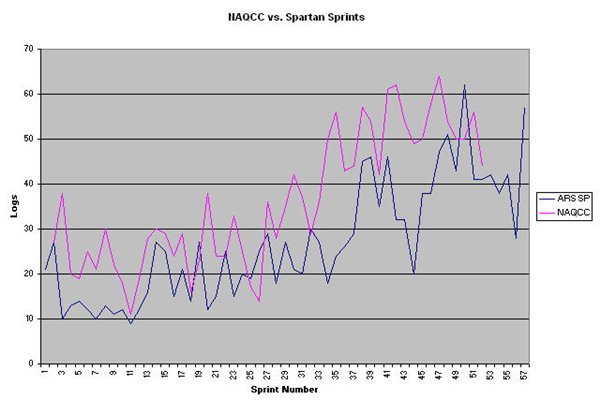 STATS - current month, previous month, all time record, mo/yr (blue indicates a record set this month): Feb Jan Rec Month Logs - 44 56 64 9/08 Autologger logs - 41 49 57 9/08 Stns in logs - 76 86 110 5/08 Hour 1 QSO's - 199 343 564 9/08 Hour 2 QSO's - 167 255 476 9/08 Total QSO's - 366 337 1040 9/08 20M QSO's - 3 2 185 6/08 40M QSO's - 152 130 709 9/08 80M QSO's - 211 465 481 12/07WINNERS: 1st SWA East - N1LU 1st SWA Central - NB4M 1st SWA Mountain - W0JFR 1st SWA Pacific - NU7T 1st Gain - n/a Special Award (having the highest total of membership numbers) Drawing Entrants: N1LU, NB4M, WY7N Drawing Winner: WY7N Congratulations to all including winners and non-winners. Actually everyone who participated and sent in a log is a winner because that shows the ham radio world that there are many folks still using and enjoying CW on the ham bands. That's one of our main goals here at the NAQCC. Very special thanks to those who reported their results even though they made only a few QSO's. Your reports are important also. We had 5 stations who didn't submit a log show up 5-17 times in the 44 logs we received and cross-checked. Hopefully those 5 and many others will be back next month AND submit a log. Remember submitting a log doubles the strength of your statement that you support CW operation. We welcome these hams who submitted a sprint log for the first time. We hope they will continue to participate and report their results: K6APW, KB4WJA, KQ1P, NB4M, VA3NU Full sprint info here. 3. GENERAL CLUB NEWS: If it catches on, and becomes popular, we might try doing it for each of the other 5 continents as well. This would give our DX members something to shoot for since a lot of our current NAQCC activities kind of leave them out in the cold. We'd be interested in hearing your thoughts on the matter at K3WWP - 11 (ineligible) W0EJ - 2 17 others tied with 1 Obviously it is still wide open right now with K3WWP not being eligible, so get out there and recruit, recruit, recruit. You'll love the book I'm offering to the winner, I'm sure. 3a. KX-1 PROJECT: As you may recall from the last KX-1 article, a problem installing the battery holders ran us out of time as Mike had a dinner engagement and had to leave just at the point where we would have done the final alignment and testing of the main KX-1 rig. 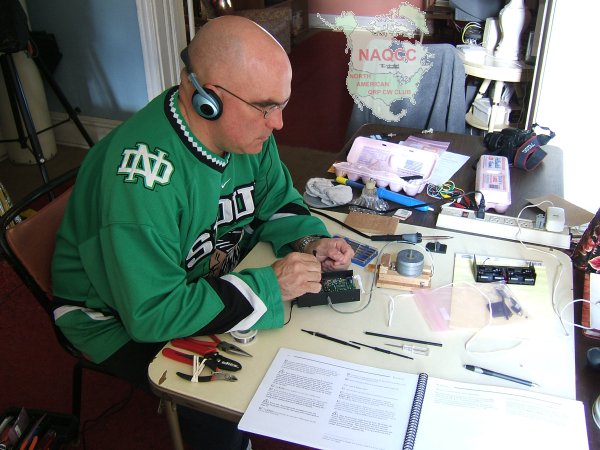 We picked up at that point, and set up our worktable and the rig for the final alignment and testing of the transmitter section with a dummy load. That went smoothly, and after re-peaking the receiving section as instructed in the manual which Mike is doing here, we were hearing a lot of RTTY stations in the CQWW RTTY contest on 20M and some CW sigs as well on 20 and 40. All we were using for an antenna was one of Mike's mobile 20M whips in the first floor of my house. In one of our first sessions we built the ATU (Antenna Tuning Unit), and our next step now was to install it on the main KX-1 circuit board. That went smoothly, and we wound up with the rig now looking like this. 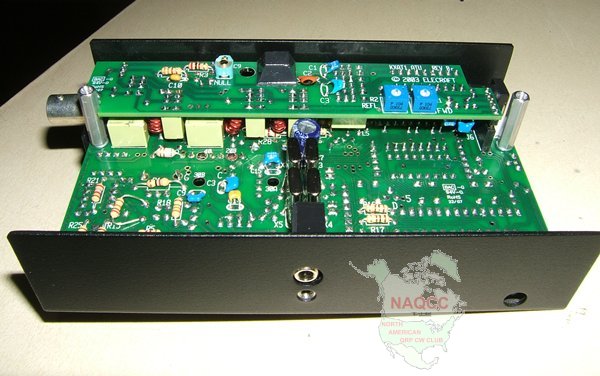 A check-out of the tuning unit started with a vivid demonstration. When Mike put on the phones to listen and turned on the rig, he was blasted with a great increase in volume over what it was with just a jumper in place of the ATU. After he recovered from that blast we continued. The check-out procedure showed that all of the relays in the ATU were functioning perfectly. The next step was moving on to the 80/30 meters accessory board. The first thing in that manual was to modify the main KX-1 board to accept the 80/30 unit. That proved to be perhaps the hardest part of the project so far. What made it hard was removing or removing/replacing several parts from the board. Even with a fine tip soldering iron and the wonderful solder sucker pictured in the last installment, getting at the solder joints in the crowded environment on the board proved daunting. After some time and some careful work we managed to get the parts removed and/or replaced. Next came one of Mike's 'favorite' procedures, a toroid winding. This one involved 33 turns on a rather tiny core, then adding a 2 turn secondary, and squeezing the finished toroid into a tiny empty place on the board while getting all 4 leads into the right holes. It was hard to wind the toroid without overlapping a couple of the windings here and there, but after a while, Mike got it wound just right, and got it mounted on the circuit board. As happened with our previous session, Mike had another dinner engagement and had to leave in just about a half hour after the toroid installation. We wanted to test out the rig upstairs in my shack, so we put the board back in its enclosure. Either because we were trying to hurry too much or for some other reason, we had trouble doing that. There is not a lot of space for the board in the enclosure and it has to be done just right while spreading out the sides of the enclosure slightly to allow the key jack to snap into its hole. We did get it together and up to my shack, but when we plugged in the headphones and turned on the power, we were greeted with dead silence. So with time running out and full of worries at what had happened, we headed back downstairs. We thought maybe the struggle getting the board in the case damaged something. When we checked with the rig's menu, we found the ATU was not working now, so we pulled it out and put a jumper in its place. Now we were getting our audio again, and wondered what happened to the ATU. We put it back in the circuit, turned on the rig and lo and behold things were working as they should again. Mike said that he noticed a difference when he inserted the ATU this time. It went in easier. So perhaps although it seems almost impossible to do, the ATU wasn't in the right way. Perhaps the pins were not in the right socket holes - maybe off by one position? We'll never know. We took the rig back upstairs and heard a myriad of strong stations all over 20 and 40M, including the pile-up for K5D on 40M. However it was now after Mike's scheduled departure time and he had to leave right then and there, so we didn't get a chance to try to work anyone. Even though it is Mike's rig, and I would like for him to make the first QSO with it, he just about insisted that I play with it and try it out. So I may do that today (2/16), or I may leave it until he comes back for the next session on Friday, 2/20. I haven't decided yet although I'm leaning toward trying it out just to be sure it does work and save us some time on Friday. We still have to build and install the 80/30 meter unit then. One thing we have noticed in building the kit is that it comes in very handy if you have someone to help you. At many points in the assembly it would have been tricky for Mike to do something without me holding this or that part or tool for him. If you must do it alone, we'd suggest you definitely have some sort of PC vise to hold the board while soldering something. Also a magnifier on a stand to examine the tiny parts and to check the solder joints, etc. One thing that might not be needed much, but would come in handy at a couple points would be a combination soldering iron and desoldering tool. Even with a vise to hold the board, it's a bit tricky to manipulate a separate iron and solder sucker in the very little space available on the board. Also to re-iterate, if you fear you can't be careful in avoiding static charges, invest in a grounding strap for your wrist, and perhaps even an anti-static mat. Mike and I worked on card tables with metal frames and were in contact with the frames most of the time we worked, and made it a point to additionally touch the frames with our hands before working on any particularly static-sensitive part. That worked out fine for us. Continuing on with the story, I did check out the rig on the air on Monday, 2/16 working WB9AZQ in TN on 40 and N5PST in TX on 20. So the basic rig and the ATU board passed the test of fire. A rig can check out perfectly, but until an actual QSO is made, there is always a little bit of doubt. That has now been removed and on to the next step on Friday now. Here are the QSL's from our first KX-1 QSO's. Both came spontaneously from the two stations without a request from us. Thanks Larry and Doug.  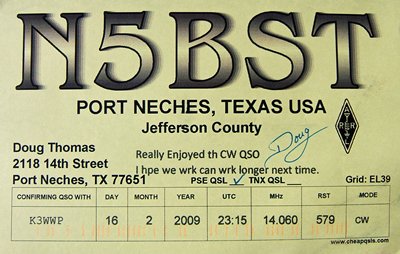 Mike had another appointment that brought him down this way on Tuesday, 2/17 so he stopped in and tried the KX-1 himself. He worked the first DX with the rig, hooking up with P49V in Aruba on 20M in an easy QSO. Let's turn the clock ahead a few days now in our story. After having his car inspected Friday morning, Mike returned around Noon that day for what we thought would be a quick job of finishing the KX-1 by installing the KB3080 module. NOT! After going smoothly for the most part in assembling the main rig, the small KB3080 board and even smaller LPF-1 board gave us more trouble than the whole main KX-1 assembly. 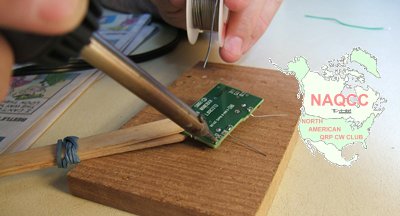 It started out easily enough with Mike soldering a couple of the wires that would mount the board to the main KX-1 board later on. It started out easily enough with Mike soldering a couple of the wires that would mount the board to the main KX-1 board later on.Things soon went downhill. The wires that connected the KB3080 to the KX-1 board were fine #24, and the stripper we had only went down to #22, so we had to improvise with an old adjustable stripper I had. It seems the opening got set just a tiny bit too small and when one of the wires snapped off, we examined it and found a nick where it had been stripped. The rest of the wires also had tiny nicks where they were stripped. So we wound up having to find some other wire in my junk box, and replacing the ones already soldered on the board. Then after doing that, we found a couple of the wires were not quite long enough to reach their mounting holes despite the fact we made them the exact length specified in the manual. So some more removing and replacing wires. That wound up taking a lot of time since it had to be done very carefully to avoid damaging the board or nearby components. 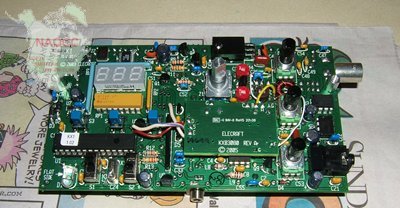 Finally after some time, we got the KB3080 board finished and mounted on the main KX-1 board as shown here. With our replacement vari-colored wires, we figure we must have one of the most colorful KX-1's around. We made the checks in the manual to be sure everything was working up to this point and it was. Finally after some time, we got the KB3080 board finished and mounted on the main KX-1 board as shown here. With our replacement vari-colored wires, we figure we must have one of the most colorful KX-1's around. We made the checks in the manual to be sure everything was working up to this point and it was.Now came the very tiny LPF-1 board, and it's smallness made for some very difficult assembly. Some of the very few parts had to be mounted and soldered so the solder connection was absolutely flush with the printed circuit board. This proved tricky, especially for holding the part in place while it was being soldered. We had this peculiar looking clamp which despite its appearance, worked fairly well. It was sensitive to heat though, and Mike had to solder very carefully. We didn't get a picture holding the LPF-1 board, but here it is holding the KB3080 board earlier with the tiny LPF board lying on the table. 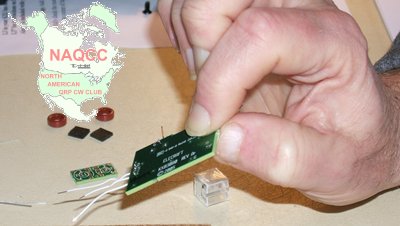 Mounting a tiny capacitor, relay, and two wires was accomplished, and then we went on to winding toroids. This was also time-consuming, and I'm sure if Mike ever buys another kit from Elecraft or if I decide to build a K2 some day, we will go with the pre-wound toroids offered by Elecraft. With a couple breaks for some food, and with Mike going along with me as I walked my neighbor's dog, Joe, it was now into the evening hours. The next step was mounting the little LPF-1 board on the main KX-1 board. This final step in the entire assembly process proved to be the most difficult of all. The components on the LPF board were so tightly packed, and the space on the main KX-1 board was so small, it proved an epic struggle to fit the board in correctly, let alone solder it. With the KXAT1 board installed, the components on it as well as the main KX-1 board virtually or actually touch those on the LPF-1 board, so the LPF-1 board has to be squeezed in somthing like trying to put toothpaste back into the tube. Then when the LPF is in place, it's impossible to visually check if anything is shorted or not connected properly as you can see from this picture. The tiny board with the two toroids and tiny capacitor visible is just to the left of the BNC connector at the right of the picture. 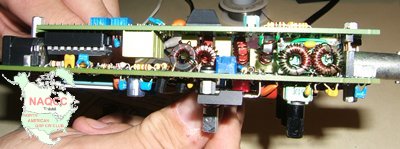 After we finally got it mounted, it was now somewhere around 8-9 PM and time to test it out. We did the receiver alignment for 80-20 meters and that worked OK. However things did not go so well for the transmitter testing. We had zero output from the rig although we could pick up the signal on my TS-480 in my shack upstairs on all 4 bands. Our guess at the moment is that we probably have a problem related to the LPF board. That's where we stand right now until the next time we get together to try to figure out the problem, and solve it. I just learned that will be on March 5th, so we'll continue with the story in our March 14th newsletter. NOTE - This series of KX-1 project articles and included pictures are the exclusive property of the NAQCC, and may not be copied in whole or in part by anyone. You may link to this entire newsletter if you wish, as long as the NAQCC is given full credit as the source of the information and pictures. 4. ELMER PROJECT: (by Karl N3IXR, Ron K5DUZ, and Fred KC8FS) - From Karl N3IJR #1770 - The Elmering Project rolls on and we do have some interest from CW ops asking for a safe place to operate at slower speeds. I would really like to make use of what used to be the Novice portion of the 40 meter band. I have suggested listening between 7.110 mhz and 7.118 mhz for slower ops. I would really like to meet some of you there to see how well it would work for a slow net. So I would like to hear from some of the faithful CW guys and those who are just getting started. Lets see if we can do a trial test on that part of 40 meters. Give me a shout, my e-mail is n3ijr@yahoo.com and we can set up a sked to test the band. I want to remind all of you that there is a wealth of information on CW operations on our NAQCC web site. Check out the CW Operating Tips section. One of my most cherished books on CW is The Art and Skill of Radio-Telegraphy, by William G. Pierpont N0HFF. You can download this book for FREE. Check it out, there is a wealth of information with many good hints. The neat thing is I did have a chance to work the author before he passed away, he was a great CW op. Thanks again to all who have shown interest and hope to see you on the bands. 73 Karl/N3IJR 5. AWARD WINNERS THE PAST TWO MONTHS: KB3ONA - 1000MPW # 0045, 0046, 0047 KC2EGL - 1000MPW # 0048, 0049, 0050 KC2RNQ - 1000MPW # 0051 N9AKF - 2XQRP 250 PTS # 0008 NB4M - DXCC # 0003 2008 PARTICIPATION AWARDS: K3WWP - EASTERN NU7T - WESTERN VE3HUR - VE/DX W2JEK - FREE FISTS MEMBERSHIP K3WWP - 2008 QSO A DAY FULL YEAR NB4M - WAC # 0010 NB4M - WAS # 0009 Also some updates to our honor rolls Interest in our awards continues to increase, and we're delighted. Awards are yet another way to show the continuing popularity of CW on the ham bands, and earning them with QRP shows the very high efficiency of CW. We now have a nice incentive to work towards and earn our NAQCC awards thanks to Gregg WB8LZG. We're sure you all know by now of our latest donation by Gregg of beautiful knob inserts for the K1 and K2 rigs. If you're not aware, check the Giveaways page in the main section of the web site for info and a picture. You can win one by earning and applying for any TWO of the following NAQCC awards. It's first come, first served, so make haste. QSO-A-DAY 30-30 Alphabet Prefix Worked Members - Advanced Suffix Words See the 'Current' page in the 'Awards' section of the web site for rules for these awards. Only new applicants on or after October 1, 2008 are eligible. Congrats go to Steve NU7T for being the very first winner of a knob insert by earning the AlphaPrefix and Suffix Words awards. Full List of all award winners here. 6. NEWS ITEMS AND ARTICLES BY OUR MEMBERS: This section is a forum for you to tell other members what you've been up to on the ham bands or to submit an article dealing with some aspect of CW and QRP operation or equipment. Send your news items and articles to our news editor Paul KD2MX at Well, there wasn't much on 40. I heard a couple more ZL's, but they didn't hear me. So I thought I'd try 80M for some Caribbean stations and possibly a new 80M country or two from that area. Having only 40 countries on 80 means there are still some (what should be) easy countries available and the competition for them at that hour should be at a minimum. Let's get right to the point now without any more preamble. In my tuning around 80M, I hear KH6MB with a good strong signal. Hmmmm, I wonder. I tried him, and indeed after a couple tries he sends K3WWP 599KW, I send TU 599 PA, and he says TU and moves on. Well, let me tell you, I was excited!! I had my doubts about ever working KH6 on 80M as my low attic antenna just doesn't put out much of a potent signal to any DX anywhere. With that one QSO, I added a new 80M state (need KL7 for 80M WAS now), a new 80M DX entity (#41), a new 80M continent (need Asia for an 80M WAC now), and a new 80M zone (Zone 31 - #13 on 80). And the QSO meant I worked 5 continents on 80M in the contest. CT9L was also a new 80M band country earlier in the test. And hey, you know what? Darned if I didn't work a second KH6 on 80 just a few minutes later in KH6LC, also an easy QSO. Then I almost got a third one in AL7O (think that was the call, can't remember for sure now), but he couldn't copy more than K3W after several tries. Strangely the fourth one I heard on 80 - KH7X should have been the easiest as he's a big contest station I've worked before on other bands, but he never heard me at all. Yes, to reinforce a well known statement - QRP WORKS, and works well with the wonderful mode of CW. It isn't easy during these days of no sunspots. And, it may be quite some time before we see them again. For old fellas like myself, it isn't a pleasant thought. Nevertheless we can't just walk away from our preferred niche of amateur radio. Not quite yet! We are, in fact experiencing radio as it was in the very early days. There was a time when a two-way radio contact was rare. And, when it occurred, it was exhilarating. We have become somewhat spoiled with instant communications; telephone, text, internet, you name it. Even fellow radio amateurs running QRO stations have become accustomed to communicating at will. So let's enjoy the thrill of a QRP contact for what it can be, a return to a time when everything wasn't quite possible, and when the impossible occurred, it was a joy. Good QRPing and I hope to find you on or near the usual CW QRP calling frequencies. I may be using my RAF straight key or WW2 era bug. If the bands are dead, I'll have my head in a book and Mozart on the cd player. Has anyone ever worked all states with all contacts qualifying as 1000 miles per watt contacts? That sounds like an interesting variation on QRP WAS. The toughest states might actually be the ones closest to you. My activity has been a little slow lately, but in late January I did chase a local special event operation here in Massachusetts. The event, for Jack Binns 100th Anniversary of the First Wireless Rescue at Sea in 1909, involved W1AA in Lakeville, MA as well as KM1CC at the Cape Cod National Seashore. Then on February 7, I spent a little time operating in the annual FYBO Winter QRP Sprint sponsored by Arizona ScQRPions. I was not able to get outdoors for this year's contest, but handed out a few contacts to some dedicated field participants. You can check out current results and soapbox at: http://www.azscqrpions.org/FYBO2009_Results.htm Since 40M seemed kind of dead yesterday, I hooked up my Icom 735 to check the other bands. I'm getting low SWR on all bands but I can't get it lower than 4:1 on 160M. I have the power down all the way and it is 10W on all bands. I Wish it could go to 5W so I qualify as QRP. The MFJ puts out 4W and that is good. I had a 1:1 SWR on all bands but 30M where the SWR was 2:1. A little after 11AM one morning, I went on the air on 7.050 and called CQ with the MFJ and got an answer. There was too much noise on the band and whoever came back to me was way down in the mud so to speak. I recognized my call right away but could not pull his out. Even with an external 4" speaker, the MFJ audio isn't the greatest. My next line of business is to get a headset. That way my aging ears will hear more. Hopefully by this summer I will have a newer all-band rig that I can run at 5W. Anyway, the thrill is back! It REALLY can be done with low power and a piece of wire. I love the NAQCC website and John's personal page and want to thank the NAQCC and my good friend Karl N3IJR for getting my CW and QRP interest back. Now I need to get a picture to put on the website. Here's an update. I'm hyped now! I just finished a 10-minute QSO with WA1ISA in Wrentham, MA. I tried calling CQ several times earlier but got no response. But this time as I was tuning the band, I heard WA1ISA calling CQ on 7.070 and figured I had nothing to lose by going back to him. He heard me loud and clear with a 589 report. We were able to make the entire QSO. It might have run longer but I ran out of things to say. He was running 100W and was really surprised to hear late I was running the MFJ-9040 with the indoor random wire. I guess you have to be on the air at the right time for a band opening! This time it worked and now I'm happy. I was also surprised that I was able to copy his approximately 20 wpm CW and just about did that fast myself with the straight key. I hope my experience and limited station can encourage others who are in my situation. Low power and a piece of wire really works. I'll be making as many QSO's on 40 with my 4W MFJ-9040 as I can, but if I hear signals on some of the other bands, I'll have to go to the Icom 735 with 10W. Later this year, there is going to be a great event called Hamfest India 2009 on November 7 and 8. It will be held in Bangalore city in southern India. W9TTY, Tom of Chicago is promoting this event and he will be traveling here for it. If you were thinking of traveling to India, please join us this coming November. Bangalore has a good international airport, fine affordable hotels, and it is also a good tourist location. |
| The publication of our next newsletter will be announced via email to all members for whom we have a valid email address unless you specifically have unsubscribed from the email. Past on-line newsletters beginning with issue #042 are now archived on the site. So if you missed seeing any past issues, you can check them out in the archives. Unless otherwise credited, all items are written by K3WWP. If you came directly to this newsletter, we invite you now to browse the NAQCC Web Site. |